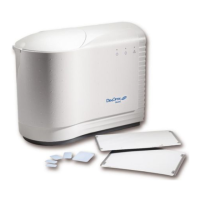032-0265-EN Rev 1 B-3
Practical Test
1. Completely erase five size 2 imaging plates by subjecting them to direct,
intense light for about 20 minutes.
2. Scan the imaging plates. No image should appear on the monitor. If an
image does appear, repeat step 1 with a more intense light source.
3. Place the imaging plates in barrier envelopes as described on page 4-3.
4. Using the exposure conditions outlined on page 4-1, expose each imaging
plate. If possible, place an object, such as an extracted tooth, in the path of
the X-ray beam.
5. Turn on your erasing light source. We recommend a light box or a minimum
l00-watt incandescent light bulb (see page 4-3).
6. Remove one imaging plate from its barrier envelope and place it with the
blue side toward the light for 2 minutes.
7. Scan the imaging plate. If an image appears, the plate was not completely
erased. Repeat step 6, adding a minute to the exposure time. Continue to
repeat until no image appears on the monitor. Record the erasing time that
resulted in no image. This is the time required to erase an unscanned
imaging plate.
8. Repeat steps 1-4. This time, under low light conditions, remove the imaging
plates from the barrier envelopes and mount them on a carousel. Scan the
imaging plates.
9. Remove the scanned imaging plates and place them, in the dark, into a
light-protected area (such as a light-tight drawer).
10. Now repeat steps 6 and 7, exposing one plate (blue side toward light) to the
erasing light for 2 minutes, the next plate for 3 minutes, etc., until you find
the point where no image appears on the monitor. This is the time required
to erase a scanned imaging plate.
The time required to erase an imaging plate will vary depending on the quality and
intensity of the erasing light source. It should be fairly easy to find a light source
that will erase imaging plates in 2-3 minutes.

